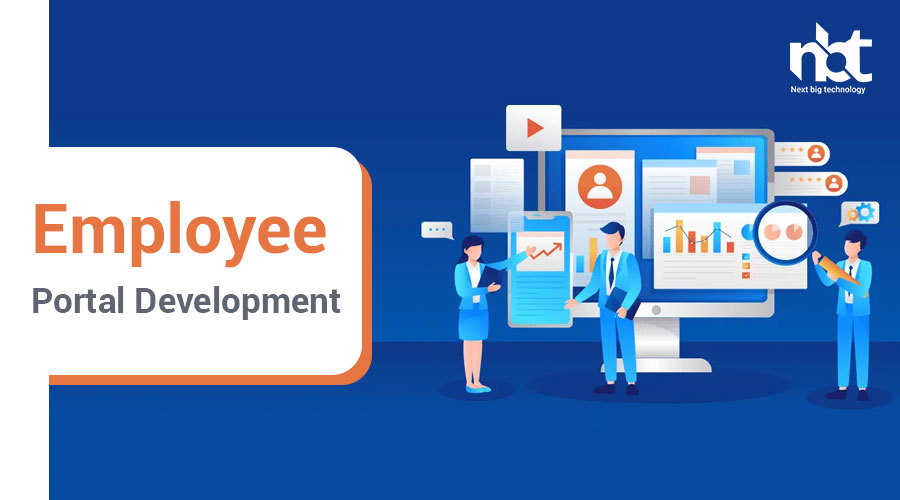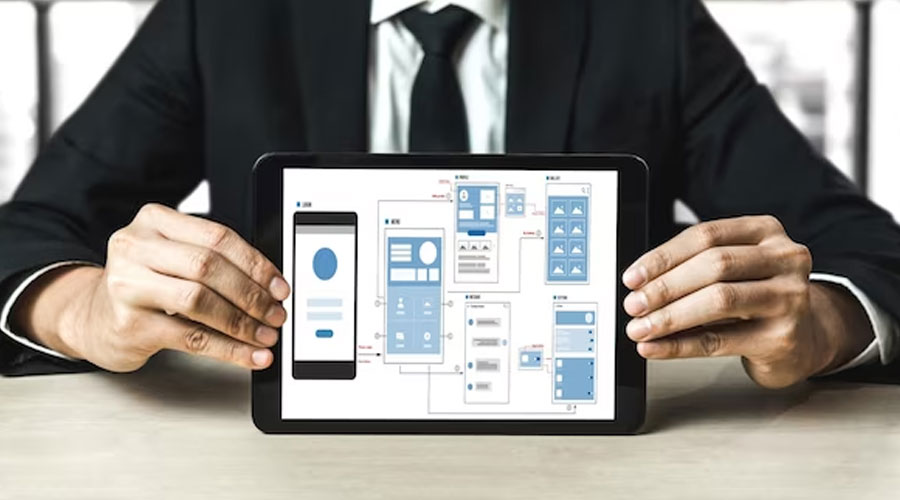Table of Contents
Employee portal development Services
In today’s fast-paced business landscape, organizations are constantly seeking ways to streamline their operations and boost productivity. One such avenue that has gained significant traction is the implementation of employee portal development services. These platforms serve as centralized hubs where employees can access a variety of tools, resources, and information essential for their roles. From HR functionalities to collaboration tools, the benefits of investing in an employee portal are manifold.
One of the primary advantages of employee portal development services is the consolidation of essential tools and information into a single, easily accessible platform. Instead of navigating through disparate systems and applications, employees can find everything they need in one place. This not only saves time but also reduces the likelihood of errors and ensures consistency across processes.
Furthermore, employee portals facilitate seamless communication and collaboration among team members, regardless of their geographical location. Features such as instant messaging, discussion forums, and document sharing promote teamwork and knowledge sharing, fostering a more cohesive and efficient work environment.
Employee satisfaction and engagement are also significantly enhanced through the implementation of a user-friendly portal. By providing employees with easy access to essential information such as company policies, benefits, and training materials, organizations demonstrate their commitment to transparency and employee development. Additionally, personalized dashboards and customizable features allow employees to tailor their portal experience to suit their preferences and needs.
From an HR perspective, employee portal development services offer a plethora of functionalities aimed at simplifying administrative tasks and improving efficiency. These may include self-service options for tasks such as submitting time-off requests, accessing pay stubs, and updating personal information. By empowering employees to manage these tasks independently, HR departments can focus their efforts on more strategic initiatives.
Security is another critical aspect addressed by employee portals. With sensitive information stored and transmitted through these platforms, robust security measures such as encryption, access controls, and multi-factor authentication are paramount. This ensures that confidential data remains protected from unauthorized access or breaches, instilling confidence in both employees and management.
In addition to these benefits, employee portal development services can also yield substantial cost savings for organizations. By streamlining processes, reducing manual intervention, and minimizing the need for multiple disparate systems, companies can realize significant efficiencies and lower operational expenses over time.
How to Create a Employee portal development
In today’s dynamic workplace environment, businesses are constantly seeking ways to streamline operations, boost employee engagement, and enhance productivity. One effective solution that addresses these needs is the development of an employee portal. An employee portal serves as a centralized platform where employees can access essential information, collaborate with colleagues, and perform various tasks efficiently. If you’re considering creating an employee portal for your organization, this step-by-step guide will walk you through the process.
- Identify Objectives and Requirements: Before diving into development, it’s crucial to identify the specific objectives and requirements of your employee portal. Determine what functionalities and features are essential for your employees. This may include access to company policies, HR resources, project management tools, communication channels, and more. Understanding your organization’s unique needs will guide the development process effectively.
- Choose a Suitable Platform: Selecting the right platform is vital for the success of your employee portal. There are several options available, including custom development, content management systems (CMS) like WordPress or Drupal, or utilizing pre-built solutions such as SharePoint or intranet software. Consider factors such as scalability, ease of customization, security features, and integration capabilities when making your decision.
- Design User-Friendly Interface: The design of your employee portal plays a significant role in its usability and adoption. Aim for a clean, intuitive interface that is easy to navigate. Pay attention to user experience (UX) principles, ensuring that information is organized logically and accessible with minimal clicks. Incorporate branding elements to reflect your company’s identity and create a sense of familiarity for employees.
- Implement Essential Features: Once you have the platform and design in place, begin implementing essential features based on your identified requirements. These may include:
- Employee Directory: A searchable database of employees with contact information.
- Document Management: Centralized storage for company policies, forms, and other documents.
- Time Tracking and Leave Management: Tools for employees to log working hours and request time off.
- Communication Tools: Chat, messaging, or discussion forums for seamless collaboration.
- Training and Development: Access to training materials, courses, and resources to support employee growth.
- Task Management: Tools for assigning tasks, tracking progress, and managing projects.
- Ensure Security and Compliance: Security is paramount when developing an employee portal, especially when handling sensitive company information. Implement robust security measures such as encryption, user authentication, role-based access controls, and regular security audits. Additionally, ensure compliance with relevant regulations such as GDPR or HIPAA, depending on your industry and location.
- Test and Iterate: Before rolling out the employee portal to the entire organization, conduct thorough testing to identify any bugs or usability issues. Gather feedback from a pilot group of users and make necessary iterations based on their input. Continuous improvement is key to ensuring that the portal meets the evolving needs of your workforce.
- Train Employees and Promote Adoption: Provide comprehensive training to employees on how to use the portal effectively. Highlight its benefits in terms of efficiency, collaboration, and access to resources. Encourage active participation and address any concerns or resistance to change. Consider implementing incentives or recognition programs to drive adoption across the organization.
- Monitor Usage and Gather Feedback: Once the employee portal is live, monitor usage metrics to track adoption rates and identify areas for improvement. Gather feedback from employees through surveys, focus groups, or direct communication channels. Use this feedback to refine and enhance the portal continuously.
Why Should You Go for Employee portal development
In today’s fast-paced business world, organizations are constantly seeking innovative ways to streamline operations, boost productivity, and foster better communication among employees. One such solution gaining traction is the development of employee portals. These digital platforms serve as centralized hubs where employees can access a wide range of resources, collaborate on projects, and stay informed about company updates. But why should your organization consider investing in employee portal development? Let’s delve into some compelling reasons.
- Enhanced Communication and Collaboration: Employee portals break down communication barriers by providing a centralized platform for sharing information and collaborating on projects. Whether employees are working remotely or in-office, they can easily connect with colleagues, share documents, and exchange ideas in real-time, fostering a culture of collaboration and teamwork.
- Increased Productivity: By consolidating essential tools, documents, and communication channels into a single platform, employee portals help streamline workflows and eliminate inefficiencies. Employees spend less time searching for information across disparate systems and can focus more on their core tasks, leading to a significant boost in productivity across the organization.
- 24/7 Access to Resources: With employee portals accessible from any device with an internet connection, employees have the flexibility to access important resources and information anytime, anywhere. Whether they need to review company policies, submit leave requests, or access training materials, everything they need is just a few clicks away, empowering them to work more efficiently, even outside traditional office hours.
- Improved Employee Engagement: Employee portals play a crucial role in keeping employees engaged and informed. Through features like company newsfeeds, event calendars, and employee directories, organizations can foster a sense of belonging and keep employees connected to the company culture, even in remote or distributed work environments.
- Streamlined HR Processes: Employee portals streamline HR processes by automating routine tasks such as leave requests, performance reviews, and onboarding procedures. This not only saves time for HR personnel but also ensures greater accuracy and compliance with company policies and regulations.
- Customization and Scalability: Employee portals are highly customizable, allowing organizations to tailor the platform to their unique needs and preferences. Whether it’s adding new features, integrating with existing systems, or expanding the portal to accommodate a growing workforce, the flexibility and scalability of employee portals make them a valuable long-term investment.
- Data-driven Insights: Employee portals generate valuable data insights that can help organizations make informed decisions about workforce management, resource allocation, and employee engagement initiatives. By tracking user activity, engagement metrics, and feedback, organizations can identify trends, measure the effectiveness of internal communications, and continuously improve the portal experience for employees.
Market Prospects of Employee portal development and Platforms
In today’s fast-paced corporate landscape, businesses are constantly seeking innovative solutions to streamline their operations and enhance employee productivity. One such solution gaining traction is the development and utilization of employee portals. These platforms serve as centralized hubs where employees can access a wide range of tools, resources, and information relevant to their roles within the organization. As the demand for efficient workforce management continues to rise, the market prospects for employee portal development and platforms are incredibly promising.
The primary driving force behind the increasing adoption of employee portals is the need for improved communication and collaboration within organizations. With remote work becoming more prevalent, companies are recognizing the importance of providing employees with easy access to essential tools and information regardless of their location. Employee portals facilitate seamless communication by enabling employees to connect with colleagues, access important documents, and collaborate on projects in real-time.
Furthermore, employee portals contribute significantly to enhancing organizational efficiency and productivity. By consolidating various functions such as HR management, performance evaluations, training modules, and internal communications onto a single platform, businesses can streamline their processes and eliminate unnecessary administrative tasks. This not only saves time and resources but also enables employees to focus more on their core responsibilities, thereby driving overall productivity.
From a strategic standpoint, employee portals offer valuable insights into workforce dynamics and employee engagement. Through analytics and reporting features, businesses can track key metrics such as employee participation rates, training completion rates, and feedback trends. These insights empower organizations to make data-driven decisions that foster a positive work culture and improve employee satisfaction.
In addition to enhancing internal operations, employee portals also play a crucial role in talent acquisition and retention. In today’s competitive job market, candidates are increasingly prioritizing employers that offer modern technology solutions to support their work. A well-designed employee portal not only serves as a testament to an organization’s commitment to employee experience but also provides a competitive edge in attracting top talent.
The market for employee portal development and platforms is witnessing significant growth, driven by the increasing digitization of workplace processes and the growing emphasis on employee experience. As businesses across industries recognize the value of investing in these solutions, the demand for customizable, feature-rich employee portals is expected to surge.
Moreover, the emergence of cloud-based and mobile-friendly employee portal solutions further expands the market opportunities. Cloud-based platforms offer scalability, flexibility, and cost-effectiveness, making them accessible to businesses of all sizes. Similarly, mobile-friendly interfaces cater to the evolving needs of modern workforce, enabling employees to access the portal anytime, anywhere from their smartphones or tablets.
Essential Features of a Employee portal development
In today’s dynamic corporate landscape, where remote work and digital connectivity have become the norm, employee portal development has emerged as a crucial tool for enhancing organizational efficiency and employee engagement. These portals serve as centralized platforms where employees can access essential resources, communicate with colleagues, and streamline various work-related processes. However, to maximize the benefits of an employee portal, certain essential features must be incorporated into its design and functionality. Let’s delve into the key elements that are integral to the successful development of an employee portal:
- User-Friendly Interface: A well-designed user interface (UI) is paramount to ensure ease of navigation and accessibility for all employees. The portal should feature intuitive design elements, clear navigation paths, and a layout that facilitates effortless information retrieval.
- Personalized Dashboard: Customization is key to catering to the diverse needs and preferences of employees. An employee portal should offer a personalized dashboard where individuals can arrange widgets, prioritize tasks, and access relevant information based on their roles and responsibilities within the organization.
- Secure Access and Authentication: Security is a top priority when it comes to employee portals, given the sensitive nature of the data they often contain. Implementing robust authentication mechanisms such as multi-factor authentication (MFA) and encryption protocols ensures secure access to the portal and protects confidential information from unauthorized access.
- Integration with HR Systems: Seamless integration with existing HR systems is essential for ensuring accuracy in employee data management and streamlining HR processes such as payroll, benefits administration, and performance evaluations. Integration with HRIS (Human Resource Information System) or HCM (Human Capital Management) software enables real-time data synchronization and enhances operational efficiency.
- Collaboration Tools: Effective communication and collaboration are vital for fostering teamwork and productivity within an organization. Integration of collaboration tools such as instant messaging, discussion forums, and project management platforms facilitates seamless communication among employees, irrespective of their geographical locations.
- Document Management System: Centralized storage and easy retrieval of documents are essential for efficient workflow management. An employee portal should include a robust document management system that allows employees to upload, share, and collaborate on documents securely. Version control and document tracking features further enhance document management capabilities.
- Employee Self-Service Functionality: Empowering employees to manage their own HR-related tasks not only reduces administrative burden but also promotes a sense of autonomy and ownership. Self-service features such as the ability to update personal information, submit leave requests, and access training materials empower employees to take control of their professional development and administrative tasks.
- Mobile Compatibility: With the increasing prevalence of remote work and the proliferation of mobile devices, it’s imperative for employee portals to be mobile-friendly. Responsive design and mobile app compatibility ensure that employees can access the portal seamlessly from their smartphones or tablets, regardless of their location.
- Analytics and Reporting: Data-driven insights are invaluable for decision-making and performance monitoring. Incorporating analytics and reporting capabilities into the employee portal enables HR managers and organizational leaders to track key metrics, identify trends, and make informed decisions to drive business outcomes.
- Feedback Mechanisms: Continuous feedback is essential for fostering a culture of growth and improvement within an organization. Incorporating feedback mechanisms such as surveys, polls, and performance reviews within the employee portal enables employees to provide feedback anonymously and facilitates constructive dialogue between employees and management.
Advanced Features Employee portal development
In today’s dynamic business landscape, companies are increasingly recognizing the pivotal role that employee portals play in enhancing operational efficiency, fostering collaboration, and driving employee engagement. As organizations strive to stay ahead in the competitive market, they are turning to advanced features in employee portal development to empower their workforce and streamline internal processes.
- Personalized Dashboards: Tailoring the employee experience is key to fostering engagement. Advanced portals allow employees to customize their dashboards based on their role, preferences, and frequently accessed information. Whether it’s accessing project updates, tracking performance metrics, or viewing upcoming deadlines, personalized dashboards ensure relevant content is readily available, boosting productivity and satisfaction.
- Integrated Communication Channels: Effective communication is the cornerstone of a cohesive workforce. Advanced portals integrate various communication channels such as instant messaging, discussion forums, and video conferencing tools, providing employees with seamless connectivity regardless of their location or device. By facilitating real-time interactions and collaboration, organizations can break down silos, stimulate idea exchange, and accelerate decision-making processes.
- Self-Service Capabilities: Empowering employees to independently manage their tasks not only reduces administrative burden but also fosters a sense of autonomy. Advanced portals offer self-service features such as leave management, expense reimbursement, and training enrollment, allowing employees to efficiently handle routine tasks without intervention from HR or administrative personnel. This not only enhances operational efficiency but also frees up resources to focus on strategic initiatives.
- Advanced Analytics and Reporting: Data-driven insights are instrumental in making informed business decisions. Advanced portals leverage analytics tools to track key performance indicators, monitor employee engagement levels, and identify trends or patterns within the organization. By harnessing actionable insights, organizations can refine strategies, optimize processes, and drive continuous improvement across the board.
- Mobile Accessibility: In an increasingly mobile-centric world, employees expect anytime, anywhere access to essential information and tools. Advanced portals are designed with responsive layouts and mobile apps, enabling employees to stay connected and productive on the go. Whether they’re attending meetings, accessing documents, or submitting requests, mobile accessibility ensures seamless interaction with the portal, enhancing convenience and flexibility.
- Integration with Third-Party Systems: To maximize functionality and streamline workflows, advanced portals offer seamless integration with various third-party systems and applications. Whether it’s syncing with CRM software, payroll systems, or project management tools, integration capabilities eliminate data silos and facilitate data exchange across disparate platforms, enabling a holistic view of operations and enhancing cross-functional collaboration.
- Role-Based Access Control: Security is paramount when it comes to handling sensitive information. Advanced portals implement role-based access control mechanisms, ensuring that employees only have access to the information and functionalities relevant to their roles and responsibilities. By enforcing granular permissions, organizations can safeguard confidential data, mitigate risks, and maintain regulatory compliance.
Employee portal development Timelines
In today’s fast-paced corporate landscape, the efficiency of internal operations is paramount to the success of any organization. Among the myriad of tools and technologies available, an employee portal stands out as a crucial asset. Serving as a centralized hub for communication, collaboration, and resource access, the development of an employee portal is a significant undertaking that requires meticulous planning and adherence to timelines.
Understanding the intricacies of employee portal development timelines is essential for businesses aiming to streamline their internal processes and enhance employee productivity. Let’s delve into the key stages and considerations involved in this process:
- Needs Assessment and Planning: Before embarking on the development journey, it’s imperative to conduct a thorough needs assessment. This involves identifying the specific requirements, functionalities, and objectives of the employee portal. Engaging stakeholders from various departments ensures that the portal addresses diverse needs effectively. Additionally, meticulous planning at this stage lays the foundation for a streamlined development process.
- Design and Prototyping: Once the requirements are documented, the next step is to design the user interface and experience. Creating prototypes and mockups allows stakeholders to visualize the final product and provide feedback early in the development cycle. This iterative approach significantly reduces the likelihood of costly revisions later on.
- Development Phase: The development phase involves translating the approved designs into a fully functional employee portal. Depending on the complexity of the project, this stage can range from a few weeks to several months. Agile methodologies are often employed to facilitate collaboration, adaptability, and efficient problem-solving throughout the development process.
- Testing and Quality Assurance: Thorough testing is essential to ensure the functionality, security, and performance of the employee portal. Quality assurance teams rigorously test every aspect of the portal, identifying and addressing any bugs or issues promptly. User acceptance testing (UAT) involves real-world scenarios to validate that the portal meets the needs of end-users effectively.
- Deployment and Training: With rigorous testing complete, the employee portal is ready for deployment. Depending on the organization’s preferences, deployment can be phased or done in a single rollout. Comprehensive training programs ensure that employees are equipped with the knowledge and skills to leverage the portal efficiently from day one.
- Ongoing Maintenance and Updates: The development timeline doesn’t end with deployment; it’s an ongoing journey. Regular maintenance, updates, and enhancements are vital to keep the employee portal aligned with evolving business needs and technological advancements. Continuous feedback from users facilitates iterative improvements, ensuring the portal remains a valuable asset to the organization.
How Much Does It Cost to Build a Employee portal development?
In today’s digital age, employee portals have become essential tools for streamlining communication, enhancing collaboration, and improving productivity within organizations. As businesses increasingly recognize the importance of investing in technology to empower their workforce, one common question arises: How much does it cost to build an employee portal?
The cost of developing an employee portal can vary significantly depending on several factors, including the complexity of features, customization requirements, scalability, security measures, and the choice of development approach (in-house development vs. outsourcing). Let’s delve into each of these aspects to understand their impact on the overall cost:
- Features and Functionality: The cost of building an employee portal primarily depends on the features and functionality you wish to incorporate. Basic functionalities such as employee directory, document management, and internal communication tools may incur lower costs compared to more advanced features like integration with third-party systems, personalized dashboards, task management, and analytics.
- Customization: Every organization has unique requirements and preferences when it comes to the design and functionality of their employee portal. Extensive customization, such as branding, tailored user interfaces, and specialized modules, can significantly increase development costs. However, customization ensures that the portal aligns perfectly with your organizational needs and enhances user experience.
- Scalability: Building a scalable employee portal is crucial to accommodate future growth and evolving business needs. Scalability involves designing the portal architecture in a way that allows for easy expansion and integration of new features without requiring a complete overhaul. While initial development costs may be higher for a scalable solution, it eliminates the need for frequent redevelopment as your organization expands.
- Security Measures: Security is paramount when it comes to handling sensitive employee data within the portal. Implementing robust security measures, such as data encryption, access controls, authentication mechanisms, and regular security audits, adds to the development cost. However, investing in security ensures data confidentiality, integrity, and protection against potential cyber threats.
- Development Approach: Choosing between in-house development and outsourcing can significantly impact the cost of building an employee portal. In-house development may involve hiring skilled developers, project managers, and investing in infrastructure, which can be expensive in the long run. On the other hand, outsourcing development to a reputable software development company or utilizing pre-built solutions can offer cost-effective alternatives while ensuring quality and timely delivery.
How to Create a Employee portal development – Team and Tech Stack
In today’s dynamic business landscape, creating an employee portal isn’t just about providing a digital space for administrative tasks. It’s about fostering seamless communication, enhancing productivity, and empowering your workforce. However, embarking on the journey of employee portal development requires careful planning, a skilled team, and the right technological tools. Let’s delve into the essential steps to create a robust employee portal and explore the ideal team composition and tech stack for the task.
Understanding the Project Scope
Before diving into development, it’s crucial to define the objectives and scope of your employee portal. Determine the key features and functionalities you want to incorporate, such as HR resources, document management, collaboration tools, and employee self-service capabilities. Conduct thorough research to understand the specific needs and preferences of your organization and employees.
Assembling the Team
- Project Manager: A skilled project manager will oversee the entire development process, ensuring timely delivery and effective communication between team members and stakeholders.
- UX/UI Designers: User experience (UX) and user interface (UI) designers play a pivotal role in creating an intuitive and visually appealing portal interface. Their focus should be on crafting an interface that is easy to navigate and enhances user engagement.
- Developers: Backend and frontend developers are responsible for bringing the design to life. Backend developers work on the server-side logic, database integration, and system architecture, while frontend developers handle the presentation layer and user interactions.
- Quality Assurance (QA) Engineers: QA engineers conduct rigorous testing to identify and resolve any bugs or issues before the portal goes live. Their role is essential in ensuring a seamless user experience and maintaining the portal’s reliability.
- Security Experts: With sensitive employee data being stored and accessed through the portal, security is paramount. Security experts will implement robust measures to protect against potential cyber threats and ensure compliance with data privacy regulations.
- Content Creators: Content creators are responsible for producing engaging and informative content for the portal, including employee onboarding materials, company policies, and instructional guides.
Choosing the Tech Stack
When it comes to selecting the right technologies for your employee portal, versatility, scalability, and security should be top priorities. Here’s a recommended tech stack:
- Backend Development:
- Framework: Choose a robust framework like Django, Laravel, or Node.js for building the backend logic and APIs.
- Database: Opt for relational databases like MySQL or PostgreSQL for structured data storage.
- Cloud Services: Utilize cloud platforms such as AWS or Microsoft Azure for scalability and reliability.
- Frontend Development:
- Framework: Use popular frontend frameworks like React.js or Angular for building dynamic and responsive user interfaces.
- Styling: Leverage CSS preprocessors like Sass or LESS for efficient styling management.
- UI Components: Incorporate UI component libraries such as Material-UI or Bootstrap to expedite development and ensure consistency.
- Security:
- Authentication: Implement secure authentication mechanisms like JWT (JSON Web Tokens) or OAuth for user authentication and authorization.
- Encryption: Utilize HTTPS protocol and SSL certificates to encrypt data transmitted between the client and server.
- Regular Security Audits: Conduct regular security audits and penetration testing to identify and address potential vulnerabilities.
- Collaboration Tools:
- Version Control: Use Git for version control to track changes and collaborate effectively with team members.
- Project Management: Utilize project management tools like Jira or Trello to streamline communication and task management.
Employee portal development Process
In the fast-paced digital age, where seamless communication and efficient workflow are paramount, organizations are increasingly turning towards employee portals to streamline their operations. An employee portal serves as a centralized platform where employees can access information, collaborate with colleagues, and perform various tasks. Developing an effective employee portal involves several crucial steps to ensure its functionality, usability, and security. In this guide, we’ll delve into the process of developing an employee portal from conception to implementation.
- Needs Assessment and Planning: Before embarking on the development journey, it’s essential to conduct a thorough needs assessment to identify the specific requirements and objectives of the employee portal. This involves gathering input from key stakeholders, including HR personnel, department heads, and end-users. Based on this assessment, a comprehensive plan outlining the portal’s features, functionalities, and user interface design is formulated.
- Design and Prototyping: With a clear understanding of the requirements, the next step is to design the user interface (UI) and user experience (UX) of the portal. This involves creating wireframes and prototypes to visualize the layout, navigation flow, and interaction elements. The design should prioritize simplicity, intuitiveness, and accessibility to ensure a seamless user experience for employees of all levels.
- Development and Integration: Once the design is finalized, developers commence the actual development process. This involves coding the backend infrastructure, databases, and frontend interface using appropriate technologies and programming languages. Integration with existing systems such as HR software, document management systems, and collaboration tools is also essential to ensure seamless data exchange and workflow automation.
- Testing and Quality Assurance: Rigorous testing is crucial to identify and rectify any bugs, glitches, or usability issues before deploying the portal. Testing involves various methodologies, including functional testing, usability testing, compatibility testing, and security testing. Quality assurance measures ensure that the portal meets the highest standards of performance, reliability, and security.
- Deployment and Training: Once the portal passes the testing phase, it is ready for deployment within the organization’s IT infrastructure. Deployment involves configuring servers, setting up user access controls, and ensuring data migration (if applicable). Additionally, comprehensive training sessions should be conducted to familiarize employees with the portal’s features, functionalities, and best practices for usage.
- Ongoing Maintenance and Optimization: The development process doesn’t end with deployment; it’s an ongoing journey of maintenance and optimization. Regular updates, patches, and security enhancements are essential to keep the portal up-to-date and resilient against emerging threats. User feedback and analytics data should also be leveraged to identify areas for improvement and optimize the portal’s performance over time.
Next Big Technology – Your Trusted Employee portal development Partner
In today’s fast-paced digital landscape, businesses are constantly seeking innovative solutions to streamline their operations and enhance employee productivity. One such solution that has gained significant traction is the development of employee portals. These portals serve as centralized platforms where employees can access important information, collaborate on projects, and engage with company resources.
However, creating a robust and user-friendly employee portal requires expertise in technology and a deep understanding of organizational needs. This is where partnering with the right technology provider becomes crucial. And when it comes to finding a trusted partner for employee portal development, Next Big Technology emerges as a leading choice.
With a proven track record of delivering cutting-edge technology solutions, Next Big Technology stands out as a reliable and competent partner for businesses looking to develop their employee portals. Here’s why:
- Expertise in Portal Development: Next Big Technology boasts a team of skilled developers who specialize in creating customized portals tailored to the unique requirements of each client. Whether it’s designing an intuitive user interface or integrating advanced features, they have the expertise to bring your vision to life.
- Focus on User Experience: A successful employee portal hinges on its usability and user experience. Next Big Technology prioritizes user-centric design principles to ensure that the portal is not only functional but also intuitive and easy to navigate. By putting the needs of end-users first, they create portals that drive engagement and productivity.
- Scalability and Flexibility: As businesses evolve and grow, their technology needs also change. Next Big Technology understands the importance of scalability and flexibility in ensuring that the employee portal can adapt to future requirements. Whether it’s accommodating a growing workforce or integrating new functionalities, they build portals that can scale seamlessly.
- Security and Compliance: Protecting sensitive employee data is paramount for any organization. Next Big Technology implements robust security measures to safeguard the integrity of the portal and ensure compliance with data protection regulations. From encryption protocols to access controls, they employ industry best practices to keep your data secure.
- Continuous Support and Maintenance: Developing an employee portal is just the beginning of the journey. Next Big Technology provides ongoing support and maintenance services to keep the portal running smoothly. Whether it’s troubleshooting technical issues or implementing updates, their dedicated support team is always there to assist.
Enterprise Employee portal development
In today’s fast-paced business environment, organizations are constantly seeking innovative ways to streamline their operations and boost productivity. One such avenue is the development of enterprise employee portals – digital platforms designed to centralize communication, collaboration, and access to essential resources within a company.
Gone are the days of cumbersome paperwork and disjointed communication channels. Enterprise employee portals offer a cohesive solution that empowers both employees and management to efficiently navigate the complexities of modern business. From onboarding new hires to facilitating cross-departmental collaboration, these portals serve as a one-stop destination for all things work-related.
So, what exactly does enterprise employee portal development entail? Let’s delve into some key aspects:
- Streamlined Communication: Effective communication is the cornerstone of any successful organization. Enterprise employee portals provide a centralized hub where employees can access company news, updates, and announcements in real-time. Whether it’s sharing project milestones or disseminating important policies, streamlined communication fosters transparency and alignment across the organization.
- Collaborative Workspace: Collaboration lies at the heart of innovation. With features such as document sharing, project management tools, and discussion forums, enterprise portals facilitate seamless collaboration among teams. By breaking down silos and encouraging knowledge sharing, these platforms drive creativity and problem-solving while eliminating inefficiencies associated with traditional communication methods.
- Resource Accessibility: Empowering employees with easy access to essential resources is essential for maximizing productivity. Enterprise portals serve as a centralized repository for documents, training materials, and procedural guidelines. Whether employees are working remotely or on-site, they can retrieve the information they need swiftly, eliminating the frustration of hunting down scattered resources.
- Personalized User Experience: Every employee is unique, with distinct preferences and responsibilities. Enterprise portals can be tailored to provide a personalized user experience, offering relevant content and features based on individual roles and interests. This customization enhances user satisfaction and ensures that employees can navigate the portal with ease, further boosting productivity.
- Enhanced Employee Engagement: Engaged employees are more motivated, productive, and committed to organizational goals. Enterprise portals foster engagement by providing platforms for feedback, recognition, and social interaction. Whether it’s participating in discussion groups or celebrating achievements, employees feel valued and connected, fostering a positive work culture.
- Data-Driven Insights: In the age of big data, leveraging insights is crucial for informed decision-making. Enterprise portals capture valuable data regarding employee engagement, usage patterns, and content preferences. By analyzing this data, organizations can identify trends, address pain points, and continuously optimize the portal to better serve employee needs.
Top Employee portal development Companies
In today’s fast-paced business landscape, employee portals have become indispensable tools for fostering communication, streamlining processes, and enhancing productivity within organizations. These portals serve as centralized platforms where employees can access important information, collaborate on projects, and engage with company resources. However, not all employee portal development companies are created equal. To help businesses make informed decisions, we’ve compiled a list of the top 5 companies that are revolutionizing workplace efficiency with their innovative solutions.
-
-
Next Big Technology:
Next Big Technology is one of the top development companies for the high-quality development of mobile apps and web development services. They have having experienced in-house team of developers who provide top-notch development services according to the business requirements. NBT provides highly business-oriented services and implements all the latest and trending tools and technologies. They always work hard to deliver a top-notch solution at an affordable cost. They are having experience of more than 13 years and delivered lots of projects around the globe to businesses and clients.
NBT is highly focused on providing top-notch development solutions at a very affordable cost. By using their market experience and development experience, they are delivering proper solutions to clients and various industries for their custom requirements.
Location: India, USA, UK, Australia
Hourly Rate :< $25 per Hour
Employees: 50 – 249
Focus Area
- Mobile App Development
- App Designing (UI/UX)
- Software Development
- Web Development
- AR & VR Development
- Big Data & BI
- Cloud Computing Services
- DevOps
- E-commerce Development
Industries Focus
- Art, Entertainment & Music
- Business Services
- Consumer Products
- Designing
- Education
- Financial & Payments
- Gaming
- Government
- Healthcare & Medical
- Hospitality
- Information Technology
- Legal & Compliance
- Manufacturing
- Media
-
- XYZ Technologies: XYZ Technologies specializes in developing employee portals that prioritize accessibility and functionality. Their intuitive interfaces make navigation effortless, empowering employees to find the information they need quickly and efficiently. From self-service features for managing benefits and payroll to interactive forums for fostering collaboration, XYZ Technologies’ portals are designed to enhance employee engagement and satisfaction.
- Elevate Solutions: Elevate Solutions sets itself apart with its emphasis on data security and compliance. Their employee portals incorporate robust security measures to safeguard sensitive information and ensure regulatory compliance across industries. With features such as role-based access controls and encryption protocols, Elevate Solutions provides peace of mind for organizations handling confidential data.
- Innovate IT: As the name suggests, Innovate IT excels in pushing the boundaries of employee portal development with cutting-edge technologies. Their portals leverage AI and machine learning algorithms to deliver personalized experiences and predictive insights. Whether it’s recommending relevant training resources or anticipating HR needs, Innovate IT’s portals are at the forefront of innovation in the workplace.
- NexGen Solutions: NexGen Solutions focuses on delivering holistic employee experiences through their portal solutions. By integrating social collaboration tools, gamification elements, and mobile accessibility, NexGen Solutions empowers organizations to create vibrant, interconnected communities within their workforce. Their emphasis on user engagement drives adoption rates and fosters a culture of continuous improvement.
FAQs on Employee portal development
In the modern workplace landscape, employee portals have become indispensable tools for streamlining communication, enhancing collaboration, and optimizing workflow management. As businesses increasingly recognize the importance of employee engagement and productivity, the demand for effective employee portals continues to rise. However, navigating the complexities of employee portal development can often lead to questions and uncertainties. To provide clarity and insight, let’s delve into some frequently asked questions (FAQs) surrounding employee portal development.
What is an Employee Portal?
An employee portal is a centralized digital platform designed to facilitate communication, collaboration, and access to resources within an organization. It serves as a one-stop destination for employees to retrieve information, complete tasks, engage with colleagues, and stay updated on company news and policies.
Why is Employee Portal Development Important?
Employee portal development plays a crucial role in fostering a cohesive and efficient work environment. By providing employees with easy access to essential tools, documents, and communication channels, organizations can enhance productivity, streamline processes, and improve overall employee satisfaction and retention.
What Features Should an Employee Portal Include?
An effective employee portal should encompass a range of features tailored to meet the specific needs of the organization and its workforce. Key features may include:
- Single Sign-On (SSO): Simplifies access by allowing employees to log in once to access multiple applications and systems.
- Document Management: Enables the storage, organization, and sharing of documents, manuals, policies, and other relevant resources.
- Task Management: Facilitates the assignment, tracking, and completion of tasks and projects.
- Employee Directory: Provides a searchable database of employee profiles, contact information, and organizational hierarchy.
- Collaboration Tools: Integration with tools such as chat, video conferencing, and project management platforms to foster teamwork and communication.
- News and Announcements: Keeps employees informed about company updates, events, and relevant news.
- Training and Development: Offers access to training materials, courses, and resources to support employee learning and skill development.
How Can an Employee Portal Benefit an Organization?
The implementation of an employee portal can yield numerous benefits for organizations, including:
- Improved Communication: Enables seamless communication and information sharing across departments and locations.
- Increased Productivity: Streamlines processes, reduces manual tasks, and enhances collaboration, leading to greater efficiency.
- Enhanced Employee Engagement: Empowers employees by providing them with access to resources, recognition, and opportunities for feedback and involvement.
- Centralized Information Repository: Consolidates important documents, policies, and resources in one easily accessible location, reducing time spent searching for information.
- Cost Savings: By automating processes and reducing administrative overhead, employee portals can contribute to cost savings in the long run.
How Long Does it Take to Develop an Employee Portal?
The timeline for employee portal development can vary depending on factors such as the complexity of requirements, customization needs, integration with existing systems, and the availability of resources. On average, the development process may take several weeks to several months from planning to implementation and rollout.
How Can Organizations Ensure the Success of Their Employee Portal?
To maximize the success of an employee portal initiative, organizations should:
- Engage Stakeholders: Involve key stakeholders, including employees, managers, and IT personnel, in the planning and development process to ensure alignment with organizational goals and user needs.
- Provide Training and Support: Offer comprehensive training and ongoing support to help employees adapt to the new system and leverage its features effectively.
- Promote Adoption and Usage: Implement strategies to encourage employee engagement and usage, such as incentives, communication campaigns, and feedback mechanisms.
- Monitor and Iterate: Continuously monitor usage metrics, gather feedback, and make iterative improvements based on user insights and evolving business requirements.
Thanks for reading our post “Employee portal development”. Please connect with us to learn more about the Employee portal.

















